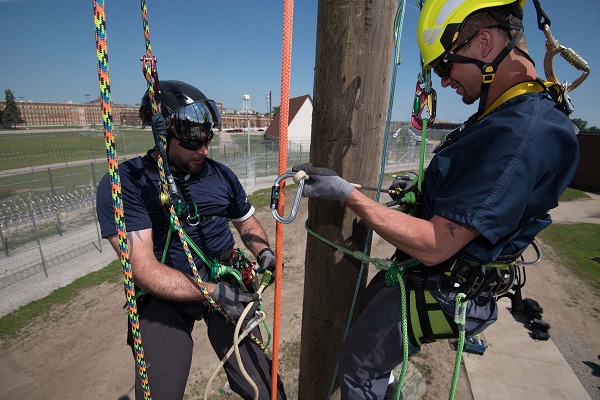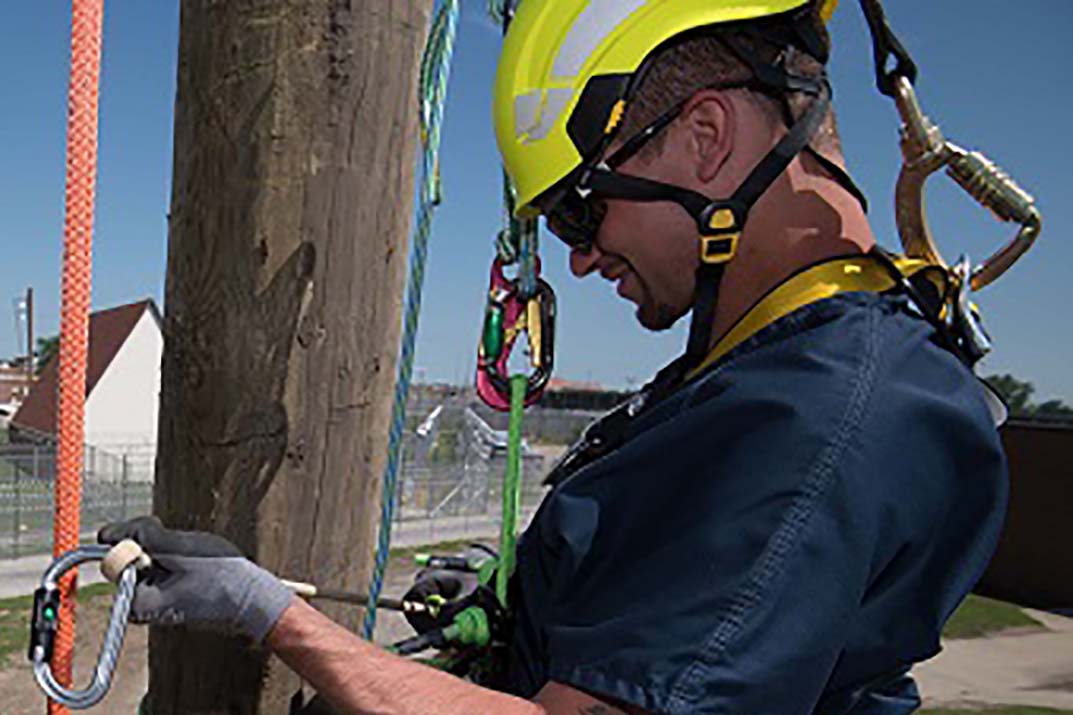Last week, Safe & Just Michigan Policy Analyst Josh Hoe and I had the opportunity to be part of a group of 20 that had a tour of the Vocational Village at the Parnall Correctional facility in Jackson. Parnall’s program is the second of its kind in the state. The first program was developed in Ionia at the Handlon facility. We were guided through the seven different programs offered and had the chance to engage with the instructors and students about the program.
When you first walk through the gates of Vocational Village, the first thing you see is the structure built to train students for the tree trimming certification. This opportunity was made available through collaboration with DTE Energy, who supplied a grant to build the structure to learn on and provided the tools needed to complete the work necessary for the training of these skills. This program, the first of its kind in the country, is currently teaching its first cohort of students.

Tree Trimming Training for incarcerated people at Parnall Correctional Facility in Jackson, Michigan. James Son (instructor, black helmet ), Corey Buerns (student). Photo courtesy Michigan Department of Corrections
While there, we were able to see another inaugural coding and web development class that had begun only three days earlier. Their skills varied greatly, from a student who had some prior experience with coding to a student who had never used a computer before starting the class.
The other vocational trades people can learn at Parnall are CNC/Robotics, commercial drivers license (CDL), carpentry, masonry and automotive. Additionally, all students acquire their forklift permit. Time permitting, students can complete more than one program in order to “stack” their credentials to be competitive in the job market.
The right person, in the right trade, at the right time
This is a phrase that was repeated by many of the Michigan Department of Corrections staff, describing the placement of people into the right training. Incarcerated persons must apply to be part of the program, and in order to qualify, they need to be within 24 months of their earliest release date, have their GED certificate or high school diploma and be misconduct-free for the last year.
Each program is comprised of classroom and hands on learning that takes place 40 hours a week. The curriculum of each program has been shaped by employer requests and industry standards. The equipment used is exceptional, from the engine that was built from practically scratch in the automotive program, to the truck simulator available to the CDL students.

Student learns robotics at the Vocational Village at the Parnall Facility. Photo courtesy of MDOC.
When determining the trade that each person will go into, several factors are considered, such as the individuals interests and aptitude as well as the demand for those skills in the community to which they will be paroled.
The purpose of the program extends beyond prison. The goal is to help incarcerated people find good jobs. Several months prior to their release, connections with employers are developed. The goal is to have job offers secured before release.
Additionally, as part of the employment readiness class they must take, the documentation needed to be eligible for work is completed. Historically, people have been released from prison without a license or state ID, social security card, or birth certificate. Acquiring these documents takes time and it’s impossible to secure legitimate employment without them. Addressing these obstacles before release sets program participants on a better path.
Reducing Recidivism
Recidivism is typically measured as the percent of people who return to prison within three years of release. The first vocational village opened in 2016, and graduates are just now approaching three-year mark, so official statistics are still in the works. However, the unofficial numbers are promising; the figure that the MDOC staff kept stating was that out of the 500 people who have graduated from the two Vocational Village programs, only 10 have come back to prison. That would be a recidivism rate of 2 percent, compared to the state’s overall rate of 28.1 percent in 2018. If this statistic bears true, this would be a significant reduction in recidivism.
When both facilities are operating at full capacity, approximately 400 people can be enrolled in the various programs at a time. While people are constantly being released on parole and replaced with new students, this is still less than 2 percent of Michigan’s prison population. This programming is innovative and seems to be successful in preparing people for their release from prison, but to make a significant decrease in the recidivism rate these programs will need to be available to more people.
A third Vocational Village is planned to open in November, at the Huron Valley Women’s Prison. This as in important step because it will open the Vocational Village programing to women for the first time.
Safe & Just Michigan supports all efforts to improve community re-entry and reduce recidivism, and hope this program continues to expand and hep more incarcerated persons.
~Anne Mahar
Research Specialist

